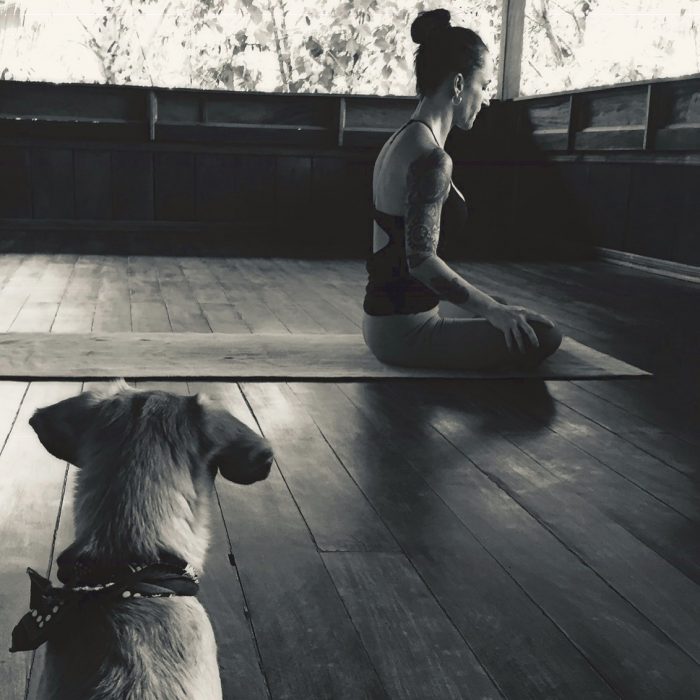COVID-19: Spiritual Bypassing & Social Responsibility
“Between stimulus and response there is a space. In that space is our power to choose our response. In our response lies our growth and our freedom.”
—Viktor Frankl
SPIRITUAL BYPASSING
I recently watched the new Netflix standup comedy with Marc Maron. One particularly hilarious segment joked about yoga teachers spiritually bypassing the current issues we are facing today with COVID-19. Another post in the New York Times described yoga teachers in the same vein. I too, can laugh at the known stereotypes of our field…but this hit home. Do we really want to be conveyed this way?
This is a very difficult time we are facing with COVID-19. Our generation has certainly not seen anything like this. But, we as a society have splintered into extreme opinions both over and under-reacting. In such times, a sensible, informed middle road is always worth examining.
Yoga professionals are pigeonholed into this stereotype of spiritual bypassing, and it’s happening because some of us are contributing to the perceptions we’re receiving. Spiritual bypassing negates the tough conversations revolving around COVID-19, believing that somehow energetically, through direct defiance that we will heal the world with a little anti-bacterial spray and our positive thinking.
As much as we as studio owners and teachers do not want to fall prey to hysteria and conspiracy theories, we must not neglect to be informed and to address the issues surrounding COVID-19 responsibly because it isn’t going to just “go away.”
ETHICS AND SOCIAL RESPONSIBILITY
I am fortunate to have a private client who is a biotech scientist with extensive background in infectious disease and her husband is a doctor serving active duty military families. I trust her guidance and expertise to inform me the difference between what is safe and what is concerning.
We must take social distancing seriously. No amount of disinfectant will protect us in large group gatherings where there are too many variabilities. We must remember that yoga-asana as a practice in group format is a collective of shared movement, breath, perspiration. Given that COVID-19 can be transmitted within six feet and remains active in the air for hours tells us where our priorities should be. The very act of congregating in the physical practice of yoga with or without contact is an obvious, irresponsible risk that helps to make an ethical decision easy.
As yoga teachers and professionals, we are generally strong, active, and healthy. I myself, am grateful for my healthy lifestyle choices that will surely help protect me from the severity of COVID-19. Therefore, I as an individual am not concerned about contracting COVID-19.
The issue at hand, is that we as healthy professionals could be carrying the virus undetected to the populations we are serving. We could be asymptomatic for weeks as we work within communities. This means, we could unknowingly transmit the virus to those who are of high-risk due to underlying health conditions and weakened immune systems.
When I first became aware of COVID-19 reaching my local communities, I immediately reduced my social influence by eliminating public classes; focusing on a small group training of six, and my private one-on-one trainings, while keeping my personal practice solitary. As of March 17, 2020 I realize this is not enough and I have placed myself in self-quarantine.
GLOBAL ECONOMY
Let’s get real here, COVID-19 is hitting our global economy and small businesses such as yoga studios and independent contractors teaching are taking this hit exponentially. For us, there is no salary. No job security. If we are not teaching, we are not profiting, and our own monthly expenses do not go away.
For me personally, as a professional who travels to teach nationally and internationally, I have thousands in deposits for my 2020 itinerary that I most likely will not be able to recover as well as events I won’t be able to complete. As of today, I have zero income…indefinitely. Of course, this is frightening and bleak.
It is said that people do the best they can with the resources we have. But we must not turn tone-deaf to the issues we are facing with COVID-19 by trying to promote our offerings as though nothing is happening. This is how we as yogis fall into the stereotypes of our industry. We are looked to as leaders in our field and people take our advice seriously—so with that power comes enormous responsibility.
SHELTER-IN-PLACE & SELF-QUARANTINE
A day after I chose self-quarantine, mandatory shelter-in-place orders were issued in California’s Bay Area, officially closing the doors of every business and studio in our industry.
As a community, we rose and adapted quick, creating live streaming and online offerings. It is powerful to witness the solidarity that can be achieved through technology even when social distancing. Staying connected through shared practice can be good medicine in these challenging times we are facing.
Still, we need to stay informed and aware of the messages we’re sending. Now, there is so much urgency to pump and promote our modified services that we risk overwhelming our communities during this time of great sensitivity.
As a yoga teacher, of course I find incalculable value in my personal practice for my physical, mental, and emotional well-being. But as professionals, we must caution against appearing tone-deaf to the emotional complexities that accompany COVID-19.
Not everyone is ready to jump back into practicing. Many are paralyzed by the weight the current headlines; the fear of the health and safety of our loved ones and families; the knot in our stomachs from the immeasurable uncertainty; and our crippling concerns of financial insecurity.
SITTING WITH THE DISCOMFORT OF UNCERTAINTY
We must remember that the practice of asana (physical postures of yoga) is only one of eight limbs or practices in yoga we observe and practice daily. In fact, asana is on the bottom tier of importance to making our yoga (union) complete.
In fact, yoga-asana practice serves to prepare us for stillness amidst life’s chaos such as this. Yoga is a means of cultivating calm and clarity regardless of our external circumstances, hardships, uncertainties, and insecurities.
Yoga at its best, teaches us how to cultivate curious enquiry; to simplify our daily living; to sit in the discomfort of our feelings without masking, adding-to, or running away.
Our current culture is a deluge of action and productivity. I am no exception to this American standard of living. I have placed an enormous amount of stress upon myself over the years working too much and self-imposed standards of over-achieving.
COVID-19 is potentially gifting us with a fast-track to deeper understanding—the actionless-action of acquiring the ability to sit with our discomfort and disease; stillness without the compulsion to fill the void with the next best thing; the mindfulness to wait patiently without trying to fix the complex matrix of extraordinary unseen that is COVID-19.
People are doing the best they can with the resources they have, of this I believe. I’ve heard people say there will only be life as we know it before and after COVID-19. Things will never be the same, and maybe they shouldn’t be. One thing is certain, we cannot keep doing what we’re doing as a fast-paced society. We are being called to respond differently, to feeling our feelings without “doing” anything.
It is my hope that at the end of this crisis we’re facing, that we can walk out of our hibernation with a little more appreciation for life’s simple things; more value in stillness and cultivating inner-clarity; less mass-production and a whole lot more intimacy; a less-is-more mentality. Perhaps this is our call to become the change we wish to see.
“It did not really matter what we expected from life, but rather what life expected from us. We needed to stop asking about the meaning of life, and instead to think of ourselves as those who were being questioned by life—daily and hourly.” —Viktor Frankl











Read 0 comments and reply